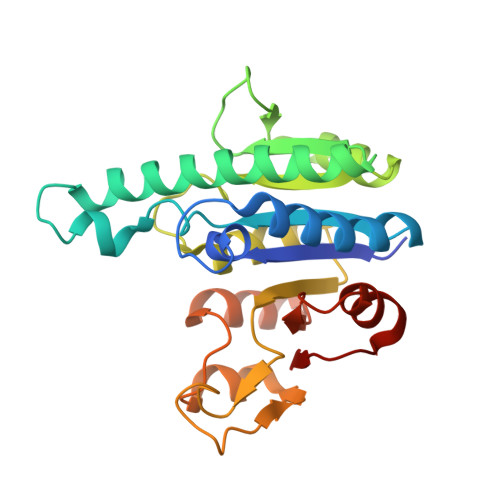Structures of Helicobacter Pylori Uridylate Kinase: Insight Into Release of the Product Udp
Chu, C.H., Chen, P.C., Liu, M.H., Li, Y.C., Hsiao, C.D., Sun, Y.J.(2012) Acta Crystallogr D Biol Crystallogr 68: 773
- PubMed: 22751662
- DOI: https://doi.org/10.1107/S0907444912011407
- Primary Citation of Related Structures:
4A7W, 4A7X - PubMed Abstract:
Uridylate kinase (UMPK; EC 2.7.4.22) transfers the γ-phosphate of ATP to UMP, forming UDP. It is allosterically regulated by GTP. Structures of Helicobacter pylori UMPK (HpUMPK) complexed with GTP (HpUMPK-GTP) and with UDP (HpUMPK-UDP) were determined at 1.8 and 2.5 Å resolution, respectively. As expected, HpUMPK-GTP forms a hexamer with six GTP molecules at its centre. Interactions between HpUMPK and GTP are made by the β3 strand of the sheet, loop β3α4 and the α4 helix. In HpUMPK-UDP, the hexameric symmetry typical of UMPKs is absent. Only four of the HpUMPK molecules bind UDP; the other two HpUMPK molecules are in the UDP-free state. The asymmetric hexamer of HpUMPK-UDP, which has an exposed dimer interface, may assist in UDP release. Furthermore, the flexibility of the α2 helix, which interacts with UDP, is found to increase when UDP is absent in HpUMPK-UDP. In HpUMPK-GTP, the α2 helix is too flexible to be observed. This suggests that GTP binding may affect the conformation of the α2 helix, thereby promoting UDP release.
- Institute of Bioinformatics and Structural Biology, National Tsing Hua University, Hsinchu 300, Taiwan.
Organizational Affiliation:

















